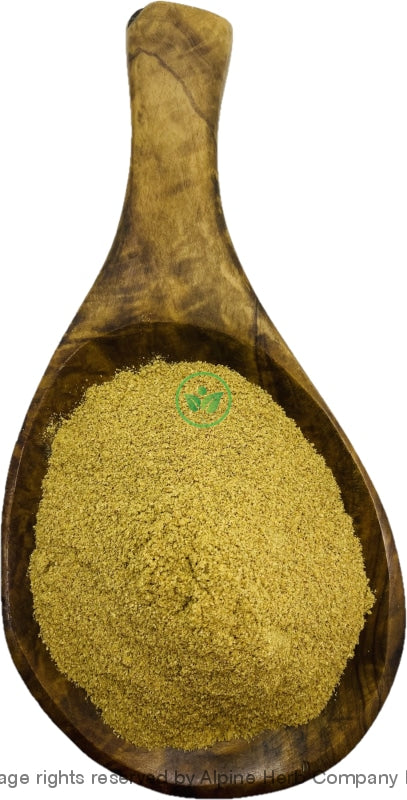Paneer Dodi Powder Alpine Herb Company Inc.
$ 11,99 $ 7,19
Botanical Name: Withania coagulans
Common Name:
- English: Paneer dodi
- Sanskrit: Rishyagandha
- Unani: Desi Asgandh, Kaaknaj-e-Hindi, Paneer, Paneer-band, Akri
- Also, known as: Paneer phool, Panner doda, Paneer doda, Panir bed, Paneer dhodi, Indian Rennet, Vegetable Rennet, Paneer booti, Indian Cheese-maker, Ammukkura, Punir, Punir bandh, Binputakah, Asvagandha, Asvagandha, Kaknaj, Asgandha, Khamjaria, Khamjira, Punirjafota, Punirband, Kaknajehindi, Punirbad, Javzulmizaja, Kaknajehindi, Spiubajja, Asvagandhi, Panneru-gadda, Hab kaknaj, Ning gu shui qie, Puni-ke-bij, Tukhme-kaknajehidi, Tukhme-kaknaje-hidi, Spiubajja, Khamjira, and Punir-ja-fota.
Habitat: India
Origin: India
Harvested: Wild
Parts Used: Fruit
General Information:
Withania coagulans is commonly recognized as ‘Indian cheese maker’ or ‘vegetable rennet’ because fruits and leaves of this flora are applied as a coagulant. One tablespoonful of which is capable to coagulate a gallon of milk in just an hour. The berries of W. coagulans are commonly used to clot milk which is called, ‘paneer’. The milk of buffalo or sheep is boiled and treated with crushed berries of the plant, tied in a fabric. This causes the milk to curdle within half an hour. Withania coagulans, is a rigid, gray-whitish small shrub, about 60-120 cm tall, branches terete, clothed with dense grey or yellowish white tomentum. The leaves are about 2-7 cm long and 1.5 cm broad, usually lanceolate-oblong, sometimes ovate, obtuse, very short-stalked, of a uniform color on both sides, thick, rugose, base acute, and running down into an often-obscure petiole; petiole 6 mm. long but often indistinct. The flowers are about 7-12 mm across, yellowish, and are dioecious and polygamous in nature. The flowers are found in axillary cymosely clusters. The berries are about 7-12 mm in diameter, red, smooth and enclosed in leathery calyx. The seeds are dark brown, ear-shaped, glabrous with a sharp fruity smell.
In ancient system of medicine, many plants have been reported to be useful to cure various health problems and diseases. Herbalism refers to traditional or folk medicine practice based on the use of plants and plant extracts. Charaka Samhita and Sushrusha Samhita give an extensive description on various medicinal plants. Medicinal plants play an important role in the development of new herbal drugs. Today, there are so many pharmaceutical prescriptions in the United States contain at least one plant-derived ingredient and Withania coagulans is one of the important medicinal plants.
How to use:
Powdered Herb:
There are different ways to use powdered herb.
Food Preparation: You can add powdered herb to any super food herbal smoothie, sauces, spreads and even cookies. Also for children, you can mix powdered herb with honey or glycerin to make paste. The thicker the paste, the more potent and herbal in taste. The sweet taste of honey and glycerin will help medicine go down. This method is also known as “Electuaries”.
Capsules: Encapsulating your own powdered herb at home, gives you assurance that the contents of the capsules are pure herb and no filler or any other products. These capsules can be taken with liquid.
Poultice: Poultice can be made with an herbal powder and liquid (mostly water) to form a paste which is then applied to the skin. This method is very helpful for skin conditions.
Herbal shot: Powdered herb can be mixed with water, fruit juice or other liquid to make herbal shot.
Precautions:
You should consult with a qualified healthcare practitioner before using any herbal products, particularly if you are pregnant, nursing, or on any medications.
All information on this website is for educational purpose ONLY
This information has not been evaluated by Health Canada.
This information is not intended to diagnose, treat, cure, or prevent any disease.
| Unit Size | 100g, 200g, 400g, 1kg |
|---|
Prompt shipping and expert packing
Thanks to our longstanding association with UPS FedEx DHL as well as other leading global carriers, we can offer a variety shipping options. Our warehouse staff is highly trained and will be able to pack your goods in accordance with our precise and exact specifications. Your items will go through an exhaustive examination before they will be securely packaged before being delivered. We ship to hundreds of thousands of customers daily in different countries. This is a sign of our determination to become the largest online retailer worldwide. Warehouses and distribution centers are located throughout Europe as well as in the USA.
Note that orders containing multiple items are processed according to the particular item.
We will thoroughly inspect all items ordered before shipping. Most orders are shipped within 48 hours. The delivery time will be between 3 and 7 working days.
Returns
The stock market is always changing. It's not entirely managed by us since we're involved with several entities, including the factory and the storage. Therefore, the actual inventory could fluctuate at any moment. Please be aware that it is possible that your order could be out of stock after you've placed your order.
Our policy lasts for 30 days. If it's been more than 30 days since the date you purchased your item We're sorry to say that we can't offer you a full exchange or refund.
You can only return a product if it is unused and still in the same state as when you received it. The item should be in the original packaging.
Related products
Herb Powder
Herb Powder
Herb Powder
Herb Powder
Herb Powder
Herb Powder
Herb Powder
Herb Powder
Herb Powder
Herb Powder
Herb Powder
Herb Powder
Herb Powder
Herb Powder
Herb Powder
Herb Powder
Herb Powder


































